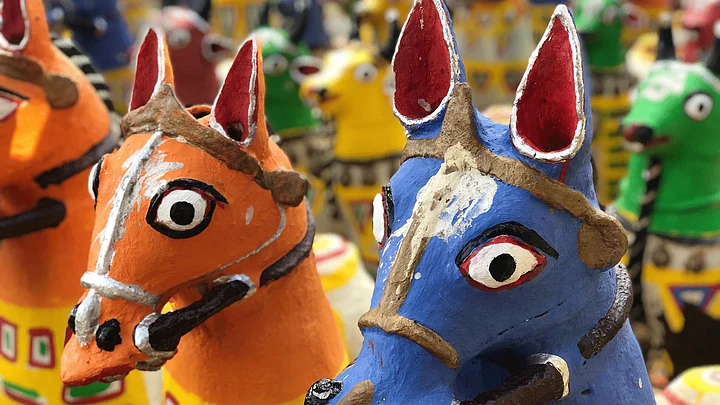At the northern edge of Alanganallur, the village near Madurai famous for its bull-taming sport jallikattu, there is a temple. This is unlike any temple you would expect – there are no ‘gopurams’, large ornate columns or even a roof.
But, this is exactly like every other temple in rural Tamil Nadu – this is a temple of village Gods.
Here’s a see-and-tell of the temple in Alanganallur, and an introduction to these Gods, who are as real to the villagers as their own neighbours.
If an urbanite were asked to draw a ‘map’ of his city, he would first trace the borders. But a villager in this part of India would begin with the temple at the centre of his village, then mark the ‘ellaii’ (boundary/limit) temples in the four corners, and then describe the village.
The temple at Alanganallur marks the village’s northern edge.
In fact, such temples can be found strewn about even in Madurai.
The chief deities in all village temples across the state are Goddesses. And the ‘Saptha Kannimaar’ – or the Seven Mothers – are found either individually in a temple, or in toto. Idols of the ‘Kannimaar’ are also worshipped inside the Meenakshi Temple in Madurai, in the inner periphery near the sanctum.
‘Muruga’ (the beautiful one) is the son of Shiva and Parvathy, also known as Karthikeya north of the Vindhyas. He has been appropriated by the Tamils as their God. During the 13th century, most of south India was under the Vijayanagara empire, and was therefore influenced by the culture and ethos of the time.
It is possible that ‘Muruga’, who is considered a Vedic God, like the trinity, found his way to the village temples during this time.
Here stands ‘Ayyanar’, also known as ‘Karuppan’ (the dark one), the protecting deity of the village, who guards against evil spirits.
The idols in village temples are either shapeless stone, or mud sculptures painted either with natural colours, or synthetic ones. While the materials have gradually changed over time, the grammar remains the same. Large eyes denote anger, which is an oversimplification of ‘power’, for which there isn’t a colloquial term.
How the ‘white horse’ came to be Ayyanar’s chosen ride is an interesting mystery. While there were local breeds of horses in Tamil Nadu a few centuries ago, none of them were known for their white colour. Even in 3,000-year-old Sangam literature, there is only mention of import of Arab horses.
The prevalent breed in Tamil Nadu today is the ‘Marwari’, which belongs to the Jodhpur regions. This breed is extremely hardy, and fast, and has been native to the state since before the Vijayanagara era.
The ears of these statues curve inward, just as with the real ‘Marwari’ horses.
This village temple in Alanganallur is special for the number of sculptures it has. Typically, village temples have the main Amman (Goddess) deity, the Ayyanar (protector), and maybe a sculpture of Ganesha, which would invariably be a recent addition.
In this temple though, the Gods have their own cavalry. Possibly because ‘Muruga’ is also the Commander-in-Chief of Shiva’s army, according to the Puranas and folklore.
The village tree, typically a banyan or a peepul, is central to the lives, beliefs and livelihoods of the people. Politics, business, and Panchayats are conducted under it.
Trees within the precincts of the temple though, are usually neem. The neem tree in Tamil Nadu is a personification of the Goddess, and is considered powerful enough to act as the messenger, or even grant wishes.
If you’re reading this, you’re probably an urbanite. In which case, Gods are either wrapped in mythology or a general belief, both of which are nebulous concepts.
But in rural Tamil Nadu, village Gods are legends. And stories around them are not simply myths that happened long ago, but memorates, or first-person accounts. The ‘Amman’ here does awaken on Navrathri. And the Ayyanar rides his horse, sword in hand, along the boundaries of the village, fighting off evil spirits.
(At The Quint, we question everything. Play an active role in shaping our journalism by becoming a member today.)
